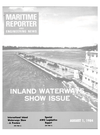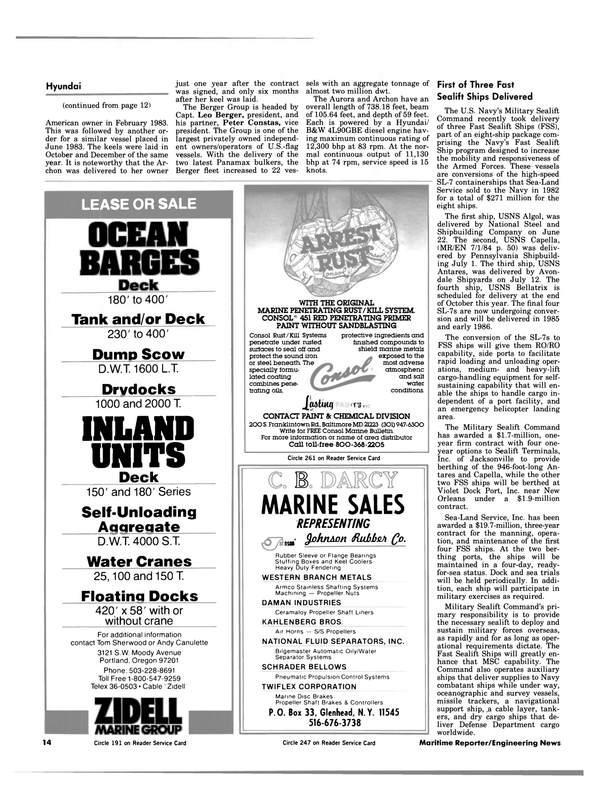
First Of Four Lauritzen Reefers Launched At Hyundai's Ulsan Yard —Two Bulkers Delivered To Apex
The Australian Reefer, first of four 630,000-cubic-foot refrigerated cargo ships under construction for J. Lauritzen A/S of Copenhagen, was launched recently at the Ulsan Shipyard of Hyundai Heavy Industries Company, Ltd.
in South Korea. These four vessels will be the largest and most modern reefers ever to be operated by the Danish company, which this year celebrates its 100th anniversary in the shipping business.
The contracts for this series of vessels were signed in April and June 1983, two in each month.
They are all scheduled to be delivered by February 1985, with the first delivery to take place in November this year.
Established in 1884, J. Lauritzen has a fleet of more than 20 ships compromising 12 reefers (plus chartered tonnage) and other vessels including bulk carriers, drillships, and jackup rigs. Most of the company's business is in reefer transport, but it also deals in dry bulk cargoes and offshore drilling.
The Australian Reefer has an overall length of 474 feet, beam of 77.4 feet, depth to upper deck of 50.5 feet, and scantling draft of 32.8 feet. She will be powered by a slow-speed Hyuandai/B&W 6L 60MCE diesel engine having a maximum continuous rating of 9,600 bhp at 107 rpm. At the normal continuous rating of 8,160 bhp at 100 rpm, she will have a service speed of 18 knots. Deadweight on scantling draft is 14,350 metric tons.
The 630,000 cubic feet of refrigerated space is contained within a BP length of only 443.5 feet, about 33 feet less than other large reefers of contemporary vintage. And, with six cargo decks rather than the usual four or five, the 50.5-foot depth is about 6.5 feet greater than most other reefers.
All cargo compartments will have a standard minimum deck height of 7.2 feet to meet the standard pallet height requirement as recommended by CIMO. Hatch Nos.
2, 3, and 4 will have five decks and hatch No. 1 will have four. This will give a total deck area of about 85,000 square feet, sufficient for about 6,100 standard pallets of 1,000 by 1,200 millimeter size.
There will be 19 separate compartments, each with its own cooling plant, divided into eight separate gastight sections to cater to any variety of mixed cargoes. Each section can independently maintain temperatures from +13 to — 25 C. Ventilation is vertical, with two fan speeds providing 45 or 90 air changes per hour.
These vessels will carry all types of perishable cargoes, from fresh produce such as bananas, apples, oranges, potatoes, and other vegetables to frozen meat, poultry, and dairy products. The large deck area is also designed for the occasional transport of cargoes such as automobiles. Container capacity is 148 TEUs, 39 on the hatch covers and 109 on the weather deck.
Two recent deliveries from Hyundai's Ulsan shipyard were the 63,800-dwt Panamax bulk carriers Aurora and Archon, built for Apex Marine Corporation of Lake Success, N.Y., a company of the Berger Group. The vessels are basically sister ships, but the second delivery, the Archon, has four electro-hydraulic deck cranes, while the Aurora (photo) is without cargohandling gear.
Hyundai signed a contract for a Panamax bulk carrier with the American owner in February 1983.
This was followed by another order for a similar vessel placed in June 1983. The keels were laid in October and December of the same year. It is noteworthy that the Archon was delivered to her owner just one year after the contract was signed, and only six months after her keel was laid.
The Berger Group is headed by Capt. Leo Berger, president, and his partner, Peter Constas, vice president. The Group is one of the largest privately owned independent owners/operators of U.S.-flag vessels. With the delivery of the two latest Panamax bulkers, the Berger fleet increased to 22 vessels with an aggregate tonnage of almost two million dwt.
The Aurora and Archon have an overall length of 738.18 feet, beam of 105.64 feet, and depth of 59 feet.
Each is powered by a Hyundai/ B&W 4L90GBE diesel engine having maximum continuous rating of 12,300 bhp at 83 rpm. At the normal continuous output of 11,130 bhp at 74 rpm, service speed is 15 knots.
Read First Of Four Lauritzen Reefers Launched At Hyundai's Ulsan Yard —Two Bulkers Delivered To Apex in Pdf, Flash or Html5 edition of August 1984 Maritime Reporter
Other stories from August 1984 issue
Content
- Captain Osborne Joins Port of San Francisco page: 6
- ASNE Northern New England Tours BIW Repair Facility page: 7
- Dockmaster's Training Seminar To Be Held Dec. 11-14, 1984 In San Diego, Calif. page: 7
- NMEA Names Gutman President, And Carney Executive Director page: 7
- ASMAR Delivers Dona Eugenia page: 7
- Lockheed Launches U.S. Navy Dock Landing Ship 'Germantown' Ahead Of Schedule page: 8
- Nav-Com Introduces New Complete Shipboard Communications Package page: 8
- AWO Elects Creelman Chairman Of The Board page: 9
- Eastern Marine Delivers Passenger Launch P.C.C. Colibri To Panama Canal Commission page: 10
- Two Smit Tak Tugs Tow Concrete Island Drilling System From Japan To Alaska's North Coast page: 10
- New Airfoil Design Makes Wind-Powered Ships Viable For Commercial Shipping page: 10
- Boghammar Marine Delivers Light-Alloy Pilot Boat page: 10
- New Members Elected To Norshipco Board page: 11
- Organizational Changes Are Announced By Newport News Shipbuilding page: 11
- First Of Four Lauritzen Reefers Launched At Hyundai's Ulsan Yard —Two Bulkers Delivered To Apex page: 12
- New Dry Dock Delivered To Southwest Marine page: 12
- North American Marine Jet Purchases Jacuzzi Marine Jet Line page: 12
- Crude Oil Tanker Exxon Baytown Christened At Avondale Shipyards page: 13
- First of Three Fast Sealift Ships Delivered page: 14
- RFD-Elliot Offers Catalogs Describing Elliot Product Line page: 14
- Edwards Will Succeed Stonebreaker As President Of Halter Marine page: 14
- Mirrlees Offers Brochure On Its K&KV Major Mk3 Diesel Engine Range page: 14
- ASMAR Of Chile In Joint Venture To Build $13-Million Shipyard page: 15
- SEACOR Wins Contracts Worth $8.4 Million page: 15
- Mississippi Marine Proves Its Strength On Mammoth Repair Job page: 16
- Verolme Botlek Awarded Contract For Rig Modification page: 16
- Flexaust Announces A Major Improvement In Its Product Line page: 16
- Seaworthy And Bethlehem Steel Offer An Innovative 1,500-TEU Class Convertible Container Carrier page: 16
- A New Fireboat For Seattle page: 17
- Blount Delivers 425-Passenger Dinner Cruise Vessel 'Riveranda' page: 17
- Literature Available On Clemlite Heavy Duty Abrasive Blast Nozzle page: 17
- Tyne Shiprepair Wins Contract To Rebuild The Sir Tristram page: 17
- Ingram Barge Company Names New President page: 17
- Fagerstrom New President Of Alfa-Laval, Inc. (U.S.) page: 18
- Orange Shipbuilding Signs Contract For Push Boat page: 18
- McDermott Announces Transfer Of Two Senior Managers page: 18
- AWO — A Legislative Report page: 20
- NAVY WORK IN PRIVATE U.S. YARDS page: 20
- Tipping Over The Pork Barrel page: 25
- AWO Regulatory Activity: A Review Of Problems — And Solutions — Currently Afloat page: 27
- AWSC: Legislation And Regulation In The Shipyard Industry page: 29
- Farrell Comments On Rail-Barge Merger page: 30
- it UNITED WE STAND 99 - A Call To Membership In The National Ocean Industries Association page: 31
- MonArk Boat Announces Promotions And Changes page: 32
- IMODCO Gets Contracts From Indonesia, India page: 32
- Dubai Drydocks Reports Successful First Year Of Operation page: 33
- Willem Pot B.V. Offers 44-Page Marine Equipment Stocklist And Catalog page: 33
- McDermott Delivers First Jumboized Crowley Barge — Gets Contract To "Stretch" Three Additional Units page: 34
- Todd Seattle A w a r d ed $500,000 Phase I Contract For LCAC Program page: 35
- Lykes A w a r d s $ 1 5 0 - M i l l i on C o n t r a c t To Build Four C o n t a i n e r s h i p s In Japan page: 35
- Hitachi Zosen Receives Jackup Drilling Rig Order From India page: 36
- 14 MarineSafety Training Courses Detailed In 12 Page Brochure page: 36
- ASTECH Offers Literature On Lightweight Steel Honeycomb Structures page: 36
- Lubritech Fuel Additive Lowers Maintenance Costs page: 37
- The Second Annual International Inland Waterways Conference & Trade Show page: 38
- OUTSTANDING WARSHIP DESIGNS page: 38
- U.S. NAVY SHIPBUILDING PROGRAM page: 44
- Literature Available On New Mechanical Pump Seals From Drew page: 46
- Midland Enterprises' President Geary Speaks Against CSX/ACBL Merger page: 46
- Krupp Atlas Has Major Orders For Atlas Polarfix — Literature Available page: 48
- New Brochure Available From American Standard Heat Exchanger Repair page: 48
- Fram Offers 20-Page Color Brochure On Its CPS-3 Marine Separator page: 48
- Aqua-Dyne Offers Brochure On Jet-Blasting Equipment page: 48
- Ferrous Announces FMS, System For Administering Catalyst Into Fuel Oil — Literature Available page: 49
- Philip Burguieres Named National Ocean Industries Association Chairman page: 49
- UNIPAR Offers Literature On Diesel Power Packs, Parts And Components page: 49
- Dillingham Delivers Massive Bridge Construction Materials To Alaska By Tandem Barge Tow page: 51
- M a c G r e g o r - N a v i re President Hanson Dies Suddenly page: 51
- Navidyne Study Shows New Satcom Antennas Save Shipowners Money page: 51
- Ferrous Offers Literature On Catalyst Proportioning Pump And Depulsing Unit page: 51
- St. Augustine Shipbuilding Vessel For Caribbean Service Designed By DeJong & Lebet page: 52
- CIME Technical Seminar Hosted By Vancouver, B.C. Branch page: 52
- NMEA Annual Meeting Set For Oct. 14-16 In Boston page: 52
- Bowditch Introduces New Navigation And Piloting Aid page: 52
- Danos & Curole Christen Jackup Barge Alyce Danos page: 52
- AVONDALE DELIVERS FAST SEALIFT SHIP USNS ANTARES TO MSC page: 53
- Dahl To Market New Improved Racor Replacement Elements page: 53
- Baatservice Building Big Catamaran Survey Vessel page: 53
- TEP 3000 Turbocharger Injector Pump Extends Turbocharger Life — Literature Available page: 54
- McDermott-Built Barge Uses Markey Machinery Windlass And Capstans page: 54
- PRC Reports On Navy Use Of PRORECO III Deck System page: 54
- New IMA Report Available Analyzing U.S. Navy Overhaul Market page: 55
- Renk Opens New Plant In South Carolina — Literature Available page: 55
- Coflexip Flexible Pipe Riser Used In Test Program By Navy page: 57
- Meyer Werft Delivers Gas Carrier And Gets Contract For Cruise Liner page: 58
- NABRICO Constructing 45 Barges For N.Y. City Department of Sanitation page: 61
- Rauma-Repola Delivers 225-Foot Salvage Tug To Soviet Union page: 62


